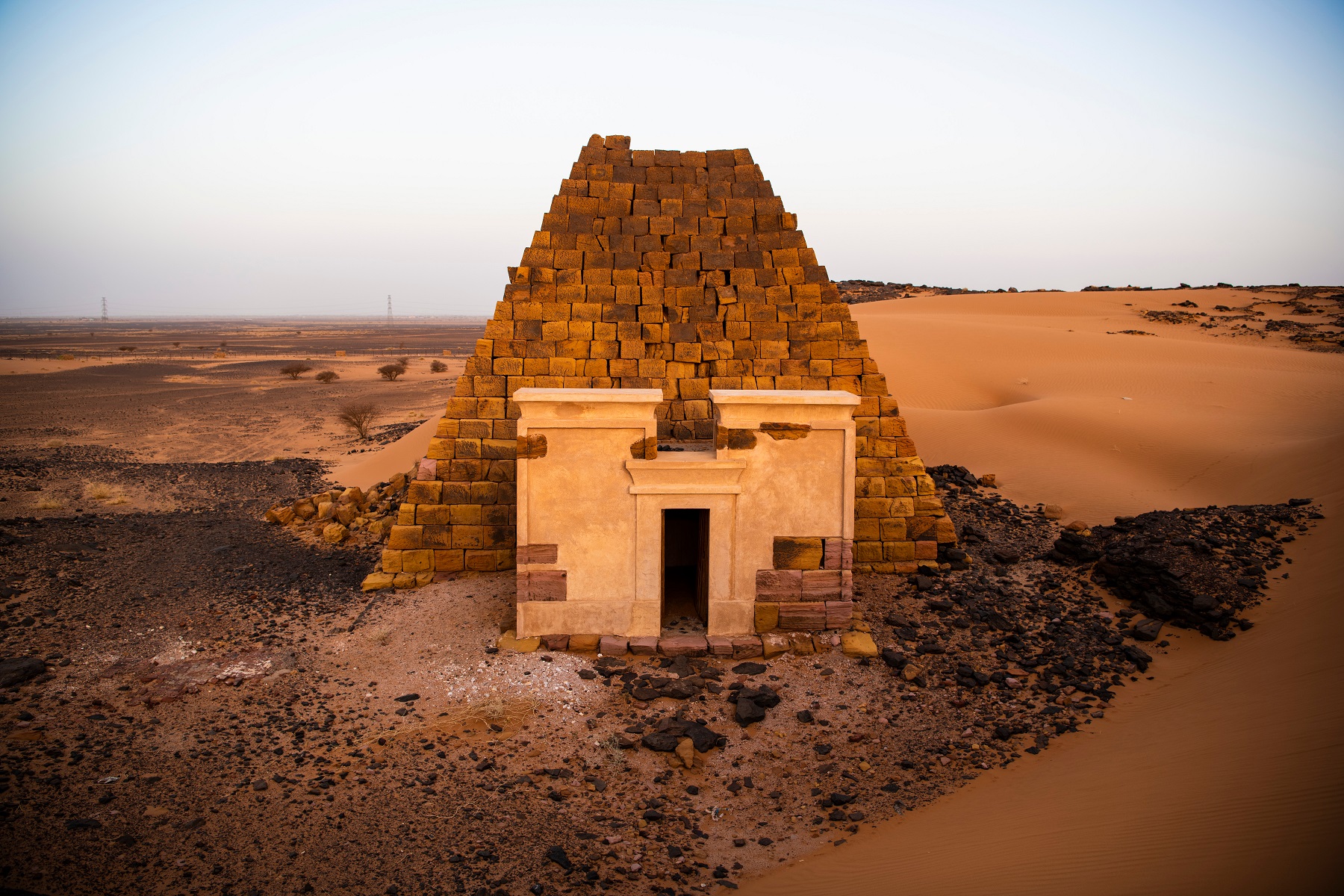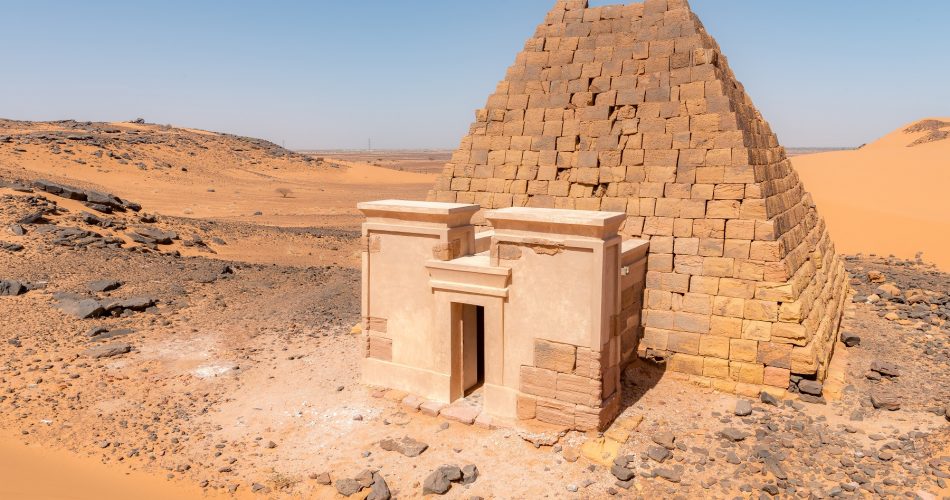Whenever I talk about pyramids, the conversation usually revolves around the famous pyramids of Giza. It makes sense—they are some of the most imposing and well-known structures in the world. I also often mention Mexico, a country where I lived for over 15 years, and the countless pyramids scattered throughout the landscape. One of my favorites is the Great Pyramid of Cholula, considered the largest pyramid on Earth by volume. However, many people don’t realize that Sudan, a country rich in history, is home to hundreds of pyramids. Though less well-known, the story of the Pyramids of Meroë is just as worthy of being told as that of the largest and most imposing pyramids on Earth.
The Pyramids of Meroë, found in what’s now Sudan, are a reminder of the history of the Kingdom of Kush. They aren’t as famous as Egypt’s pyramids, but that doesn’t make them any less interesting. Sitting along the Nile, these pyramids are smaller and steeper than their Egyptian counterparts. Built for kings, queens, and nobles of the Kushite kingdom, which lasted from around 800 BCE to 350 CE, these tombs tell a story of power and culture. Sure, they don’t get the same attention as Giza’s pyramids, but they reveal an equally impressive chapter of history along a different stretch of the Nile.
The Kingdom of Kush: Meroë’s Role in History
But before we go into detail, allow me to delve a bit deeper into the kingdom that erected these fascinating structures. So, the kingdom of Meroë was the capital of the Kushite Empire (Kingdom of Kush) for centuries and was a major center for culture, trade, and power. The city itself was a thriving place, filled with palaces, temples, and, of course, pyramids. The kings and queens of Kush were buried here in the royal cemetery, with their tombs meant to last forever. The pyramids of Meroë are smaller than the ones in Egypt (much smaller), averaging around 30 meters tall, but there’s strength in numbers—over 200 pyramids are scattered across the area.
What Makes the Meroë Pyramids Different
So if the pyramids of Meroë aren’t as impressive, why bother mentioning them? Well, because despite the fact that they might not be as big as the structures in Egypt or Mexico, the pyramids offer important architectural details about that time period and the connection to their bigger Egyptian counterparts.
Unlike Egypt’s massive, broad pyramids, the pyramids of Meroë are steep and narrow. They were built on a sandstone base, with walls often decorated with carvings of gods, religious symbols, and scenes from royal life. These weren’t just burial sites—they were symbols of power, marking the resting place of kings, queens, and nobles. Many of them even had chapels at the base where offerings were left.
Sadly, a lot of these pyramids were damaged in the 1800s when an Italian treasure hunter named Giuseppe Ferlini went digging for gold. In his search, he destroyed the tops of many pyramids. Though he did find some jewelry, his reckless actions caused permanent damage to these amazing structures.

An image showing the pyramids of Meroë, north of Khartoum in Sudan. Shutterstock.
5 Little-Known Facts About the Pyramids of Meroë
There Are More Pyramids in Sudan Than in Egypt
When people think of pyramids, their minds often go straight to Egypt. However, Sudan actually has more pyramids than Egypt—over 200 pyramids are scattered across the Meroë region alone, compared to Egypt’s 138. The sheer number of pyramids in Sudan highlights the cultural and religious importance of these structures to the Kushite people.
Kushite Kings Ruled Egypt as Pharaohs
At one point, the rulers of the Kingdom of Kush, often called the Black Pharaohs, took control of Egypt and ruled as pharaohs during the 25th Dynasty. These kings brought their unique culture, blending it with Egyptian traditions, and their pyramids at Meroë are a reflection of this fusion. You can see a mix of Egyptian and local influences in the carvings and architecture.
Meroë Was an Iron-Producing Hub
While Egypt was known for its great stone monuments, the Kingdom of Kush was famous for its iron production. The city of Meroë was an industrial center, with massive furnaces producing tools and weapons. This iron trade made the kingdom wealthy and powerful, allowing it to build such grand structures as the pyramids.
They’re Much Younger Than the Egyptian Pyramids
While Egypt’s pyramids were built around 4,500 years ago, the pyramids of Meroë are relatively younger, built between 800 BCE and 350 CE. By the time the Kushite pyramids were constructed, Egypt had already left its pyramid-building days behind, but the Kushites carried the tradition forward in their own way.
Meroë’s Pyramids Had Chapels for Worship
Each pyramid in Meroë had a small chapel at its base. These chapels were where offerings were made to the deceased kings and queens. The people of Kush believed that their rulers would need provisions for the afterlife, just like the Egyptians, and these chapels were places of ritual and remembrance.
The Sacredness of Meroë’s Tombs
The pyramids of Meroë may not be as towering or famous as those in Egypt, nor have the massive (mind-boggling) volume of some of the pyramids in Mexico, but they were just as meaningful to the people of the Kingdom of Kush. These pyramids weren’t just tombs; they were sacred places where the rulers were laid to rest, along with treasures and supplies for the afterlife. Everything was built to align with the beliefs of the time, ensuring the spirits of the dead had a smooth journey to the next world.
Archaeologists have discovered not only the burial chambers but also chapels where visitors could leave offerings. Inside these chapels, intricate carvings of gods and symbols tell stories of the deceased’s passage to the afterlife. It’s easy to imagine what these tombs looked like when they were first built, gleaming in the desert sun with their bright stones.
Today, Meroë’s pyramids offer a rare glimpse into the power and influence of the Kingdom of Kush. Although less known than Egypt’s pyramids, they reveal a fascinating civilization that thrived just south of Egypt. Now a UNESCO World Heritage Site, Meroë continues to be excavated, offering new insights into this incredible ancient culture. For visitors, the pyramids of Meroë provide an unforgettable experience. Unlike the tourist-heavy sites of Giza, Meroë’s pyramids sit quietly in the desert, letting you take in the stark beauty and imagine what life was like in this ancient empire.

